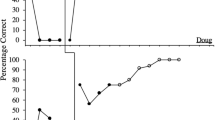Abstract
This study investigated the association between therapeutic riding (TR) and the social communication and sensory processing skills of 21 elementary students with autism attending TR as part of a school group. An interrupted treatment design was employed to determine whether children were able to maintain treatment effects following the removal of TR. Teacher ratings indicated that participating children with autism significantly increased their social interaction, improved their sensory processing, and decreased the severity of symptoms associated with autism spectrum disorders following TR. Gains were not maintained consistently after two 6-week breaks from TR, but were recovered once TR was reinstated. Potential explanations regarding the benefits of TR are discussed, and suggestions for future research provided.

Similar content being viewed by others
References
American Psychiatric Association. (2000). Diagnostic and statistical manual of mental disorders—Fourth edition, text revision. Washington, DC: American Psychiatric Association.
Bass, M. B., Duchowny, C. A., & Llabre, M. M. (2009). The effect of therapeutic horseback riding on social functioning of children with autism. Journal of Autism and Developmental Disorders, 39, 1261–1267. doi:10.1007/s10803-009-0734-3.
Bracken, B. A., & Keith, L. K. (2004). The clinical assessment of behavior. Lutz, FL: Psychological Assessment Resources.
Brown, H. M. (1996). “Intrusion” interaction therapy for riders with autism. Strides, 2(3), 22–23.
Burgon, H. L. (2011). ‘Queen of the world’: Experiences of ‘at-risk young people participating in equine-assisted learning/therapy. Journal of Social Work Practice, 25, 165–183. doi:10.1080/02650533.2011.561304.
Dunn, W. (2006). The sensory profile school companion. San Antonio, TX: Pearson.
Earles-Vollrath, T. L., Cook, K. T., Robbins, L., & Ben-Arieh, J. (2008). In R. L. Simpson & B. S. Myles (Eds.), Educating children and youth with autism: Strategies for effective practice (2nd ed., pp. 93–178). Austin, TX: Pro-Ed.
Gabriels, R. L., Agnew, J. A., Holt, K. D., Shoffner, A., Zhaozing, P., Ruzzano, S., et al. (2012). Pilot study measuring the effects of therapeutic horseback riding on school-age children and adolescents with autism spectrum disorders. Research in Autism Sectrum Disorders, 6, 578–588.
Gilliam, J. E. (2006). The gilliam autism rating scale (2nd ed.). Austin, TX: Pro-Ed, Inc.
Herbert, M. R. (2011). The neuroanatomy of ASD. In D. A. Fein (Ed.), The neuropsychology of autism (pp. 47–76). New York, NY: Oxford University Press, Inc.
House, A. E. (2002). DSM-IV diagnosis in the schools. New York: The Guilford Press.
Johnson, M. D. (2007). The sound of a miracle. Strides, 13(2), 10–11.
Kohn, D. (1996). Autism and therapeutic riding. Strides, 2(3), 24–25.
Mesibov, G. (2012). Pilot study measuring the effects of therapeutic horseback riding on school-age children and adolescents with autism spectrum disorders. Research in Autism Sectrum Disorders, 6, 578–588.
Mundy, P., Mastergeorge, A. M., & McIntyre, N. S. (2012). Effects of autism on social learning and social attention. In P. Mundy & A. M. Mastergeorge (Eds.), Educational interventions for students with autism. San Francisco: Jossey-Bass.
Odom, S. L., Collet-Klingenberg, L., Rogers, S. J., & Hatton, D. D. (2010). Evidence-based practices in interventions for children and youth with autism spectrum disorders. Preventing School Failure, 54(4), 275–282. doi:10.1080/10459881003785506.
Pauw, J. (2000). Therapeutic horseback riding studies: Problems experienced by researchers. Physiotherapy, 86, 523–527. doi:10.1016/S0031-9406(05)60986-8.
Professional Association of Therapeutic Horsemanship International. (2009). NARHA-EAAT Fact Sheet. Retrieved from http://www.pathintl.org/resources-education/resources/eeat.
Prothmann, A., & Fine, A. H. (2011). Animal-assisted interventions in child psychiatry. In P. McCardle, S. McCune, J. A. Griffin, L. Esposito, & L. S. Freund (Eds.), Animals in our lives: Human-animal interaction in family, community and therapeutic settings (pp. 143–162). Baltimore, MD: Paul H. Brooks Publishing.
Shoffner, A., & Gabriels, R. (2011). Autism and therapeutic riding: A pilot study. Strides, 18(2), 11–15.
Šidák, Z. (1967). Rectangular confidence regions for the means of multivariate normal distributions. Journal of American Statistical Association, 62, 626–633.
Snider, L., Korner-Bitensky, N., Kammann, C., Warner, S., & Saleh, M. (2007). Horseback riding as therapy for children with cerebral palsy: Is there evidence of its effectiveness? Physical and Occupational Therapy in Pediatrics, 27(2), 5–23.
Tsatsanis, K. D. (2005). Neuropsychological characteristics in autism and related conditions. In F. R. Volkmar, P. Rhea, A. Klin, & D. Cohen (Eds.), Handbook of autism and pervasive developmental disorders (3rd ed., pp. 772–798). New York: Wiley.
Volker, M. A., & Lopata, C. (2008). Autism: A review of biological bases, assessment, and intervention. School Psychology Quarterly, 23, 258–270. doi:10/1037/1045-3830.23.2.258.
Volkmar, F. R., & Wiesner, L. A. (2009). A practical guide to autism. Hoboken, NJ: Wiley.
Ward, S. C., Whalon, K., Stiles, K., & Smith, A. (2011). The effects of therapeutic horseback riding on children with autism. San Francisco, CA: Poster presented at the annual meeting of the National Association of School Psychologists.
Acknowledgments
The authors wish to acknowledge the contributions of Wade Johnson, M.D. to the design and critique of this study.
Author information
Authors and Affiliations
Corresponding author
Rights and permissions
About this article
Cite this article
Ward, S.C., Whalon, K., Rusnak, K. et al. The Association Between Therapeutic Horseback Riding and the Social Communication and Sensory Reactions of Children with Autism. J Autism Dev Disord 43, 2190–2198 (2013). https://doi.org/10.1007/s10803-013-1773-3
Published:
Issue Date:
DOI: https://doi.org/10.1007/s10803-013-1773-3




